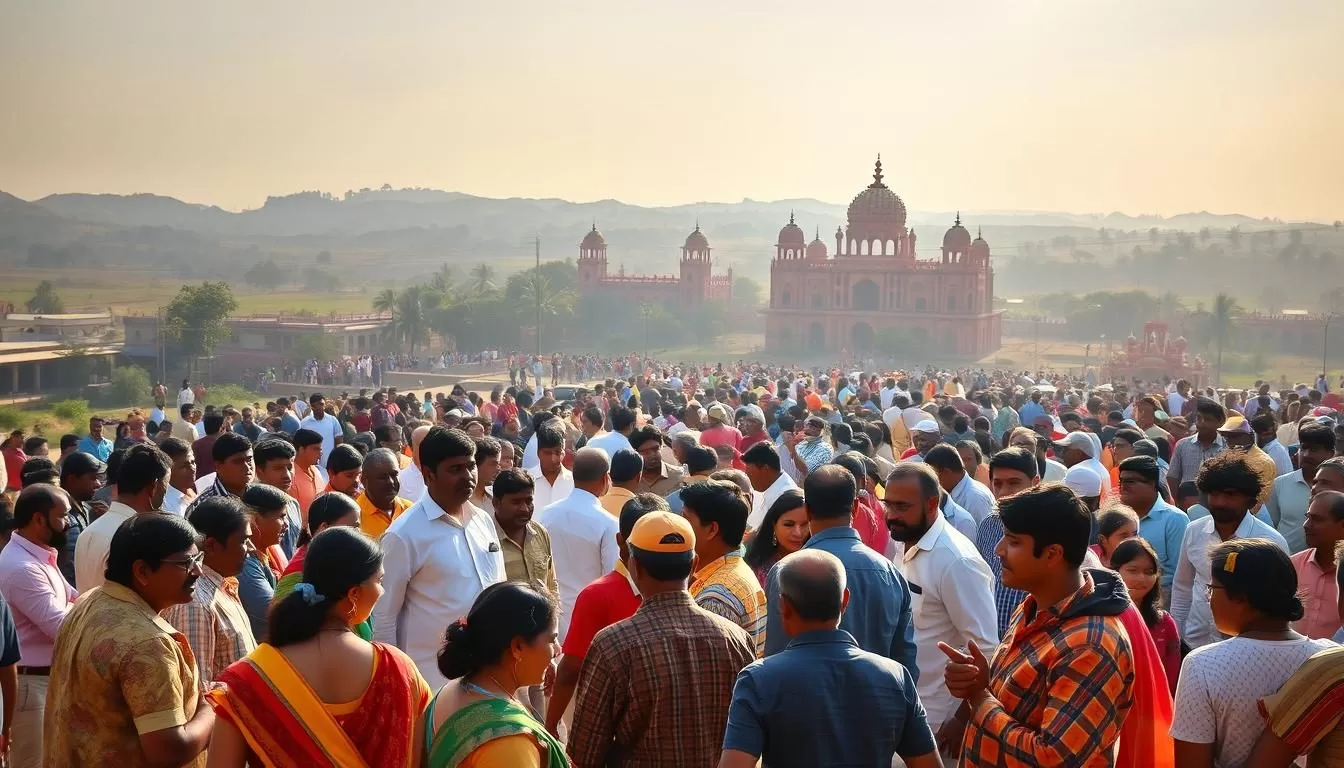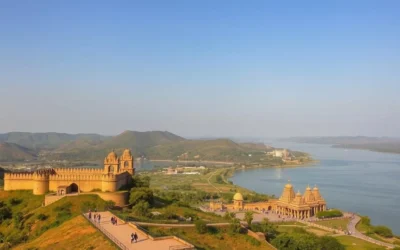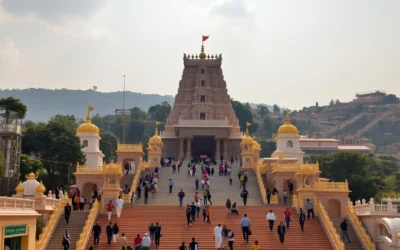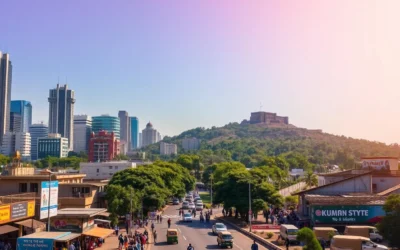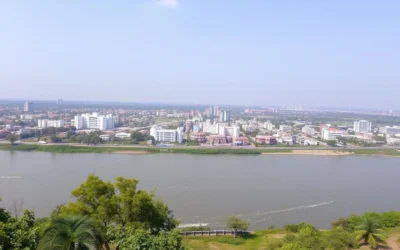✓ Accommodations✓ Flights✓ Rental Cars✓ Tours & Activities
You’re about to explore the rich linguistic landscape of Andhra Pradesh, a state in India known for its cultural diversity.
Telugu is the official language, playing a significant role in the state’s cultural identity. However, the state’s population is highly diverse, with various languages spoken across different regions, including Urdu, Hindi, Tamil, Kannada, Bengali, Odia, and Marathi.
This diversity is not just about the language spoken; it’s also deeply connected to the social and cultural contexts of the people. As you delve into this article, you’ll gain a deeper understanding of how language shapes the cultural fabric of Andhra Pradesh.
The Linguistic Landscape of Andhra Pradesh
As you explore Andhra Pradesh, you’ll discover a vibrant tapestry of languages that have evolved over centuries. This linguistic diversity is a hallmark of the state’s rich cultural heritage.
Geographic and Demographic Overview
Andhra Pradesh is located in the southern part of India, bordering Tamil Nadu to the south, Karnataka to the west, and Odisha to the north. The state’s diverse geography, including coastal regions, mountains, and plains, has contributed to its linguistic diversity. With a population of over 49 million, Andhra Pradesh is home to various ethnic and linguistic groups.
| Language | Speakers | Regions |
|---|---|---|
| Telugu | Majority | Statewide |
| Urdu | Minority | Urban areas |
| Tamil | Border regions | Southern districts |
Language Diversity in Context
The language diversity in Andhra Pradesh is not just a reflection of its demographic makeup but also a result of historical and cultural factors. Telugu is the official and most widely spoken language, while Urdu is spoken by a significant minority. Border-area languages like Tamil, Kannada, and Odia are also prevalent, reflecting the state’s geographic position.
You can see how the distribution of languages across different districts and regions of the state contributes to its linguistic richness. Understanding this diversity is crucial for appreciating the cultural identity of various groups within Andhra Pradesh.
Telugu: The Official Language of Andhra Pradesh
Telugu, the official language of Andhra Pradesh, boasts a rich history that spans centuries, deeply influencing the cultural fabric of the region. As you delve into the world of Telugu, you’ll discover its significance not just as a means of communication, but as a carrier of the region’s cultural heritage and traditions.
Historical Development of Telugu
The history of Telugu is a fascinating tale of evolution, from its ancient roots to its current status as a thriving language. Emerging from the Dravidian language family, Telugu has been influenced by various cultures and dynasties that have ruled the region over the centuries. This historical development has enriched Telugu, making it a unique blend of different linguistic traditions.
Telugu’s Status as a Classical Language
In recognition of its rich heritage and independent nature, the Government of India has awarded Telugu the distinction of a classical language, a status shared by other venerable languages such as Tamil and Sanskrit. This recognition underscores Telugu’s significance in the cultural landscape of India and highlights its contribution to the country’s linguistic diversity.
| Classical Language | Year of Recognition | Significance |
|---|---|---|
| Telugu | 2008 | Rich heritage and independent nature |
| Tamil | 2004 | Ancient literary tradition |
| Sanskrit | Classical language of India | Ancient language of India |
Literary Traditions and Cultural Significance
Telugu literature is renowned for its rich traditions, spanning from ancient poetry to modern novels. The language has been a medium for numerous influential writers and poets who have shaped its literary landscape. The literary works in Telugu not only reflect the historical and social developments of the region but also play a crucial role in preserving its culture. As you explore Telugu literature, you’ll gain a deeper appreciation for its contribution to the world of languages and its continued evolution in the modern era.
Major Telugu Dialects in Andhra Pradesh
The Telugu language in Andhra Pradesh is spoken in various dialects, reflecting the state’s rich linguistic diversity. As you explore the different regions of Andhra Pradesh, you’ll notice distinct variations in the way Telugu is spoken.
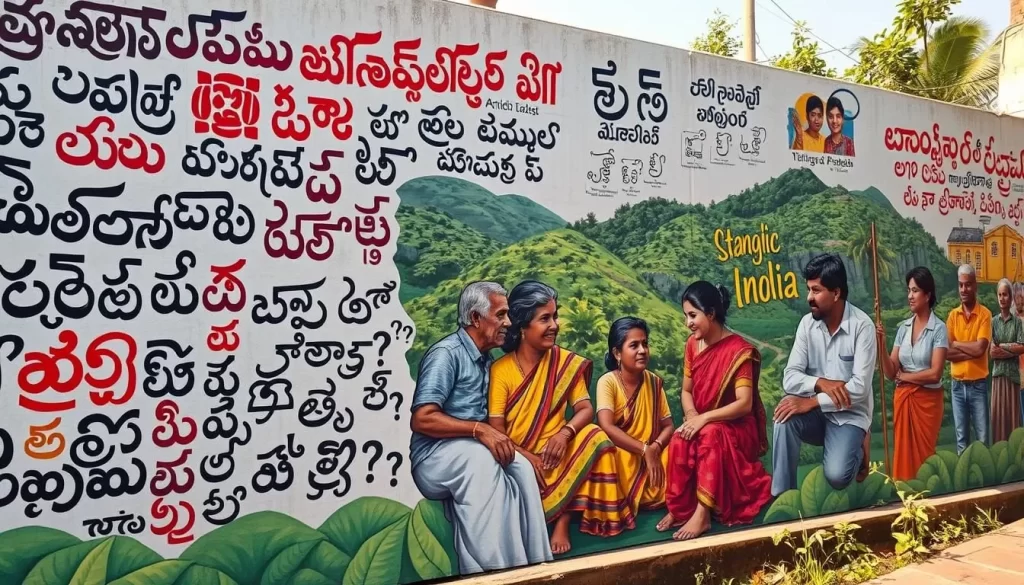
Coastal Andhra Dialect
The Coastal Andhra dialect is one of the prominent dialects spoken in the coastal regions of Andhra Pradesh. This dialect has been influenced by the state’s maritime history and cultural exchange with other regions. You might notice that the Coastal Andhra dialect has unique vocabulary and pronunciation, shaped by the region’s distinct cultural identity. The dialect is widely used in the districts of Krishna, Guntur, and East Godavari.
Key features of the Coastal Andhra dialect include:
- Distinctive pronunciation and intonation
- Influence from other languages due to maritime trade
- Unique vocabulary related to local customs and traditions
Rayalaseema Dialect
The Rayalaseema dialect is another significant dialect spoken in the Rayalaseema region of Andhra Pradesh. This dialect has its own distinct flavor, shaped by the region’s history and geography. You’ll find that the Rayalaseema dialect has retained many traditional words and expressions, giving it a unique character. The dialect is commonly used in the districts of Kurnool, Kadapa, and Anantapur.
Notable aspects of the Rayalaseema dialect:
- Retention of traditional vocabulary
- Influence from neighboring languages
- Distinctive grammatical structures
Other Regional Variations
Apart from the Coastal Andhra and Rayalaseema dialects, there are other regional variations of Telugu spoken in Andhra Pradesh. These dialects are shaped by local factors such as geography, culture, and occupation. You might come across dialects that are specific to certain communities or regions, adding to the state’s linguistic diversity. For instance, the dialect spoken in the hilly regions may differ from that spoken in the plains.
As you explore these regional variations, you’ll gain a deeper understanding of the complex linguistic landscape of Andhra Pradesh. The diversity of Telugu dialects is a testament to the state’s rich cultural heritage, and ongoing research and documentation efforts are helping to preserve these unique linguistic traditions.
Urdu: The Second Most Widely Spoken Language
Andhra Pradesh, known for its rich cultural heritage, is home to a substantial Urdu-speaking population. While Telugu is the official language, Urdu holds a significant place in the state’s linguistic diversity.
Historical Presence of Urdu in Andhra Pradesh
Urdu has a long historical presence in Andhra Pradesh, dating back to the period of Muslim rule in the region. The language was patronized by various dynasties, including the Qutb Shahi and Asaf Jahi dynasties, which contributed to its growth and spread. As a result, Urdu became an integral part of the cultural fabric, influencing local languages and literature.
Current Usage and Distribution
Today, Urdu is spoken by a significant minority in Andhra Pradesh, particularly in urban areas. The language is used in various contexts, including education, media, and official communications, albeit to a limited extent. Urdu speakers are found across different regions, with notable concentrations in cities like Hyderabad and other urban centers. The demographic profile of Urdu speakers reveals a diverse group, with varying levels of proficiency in the language. Efforts to preserve Urdu literacy and promote its use in contemporary society are ongoing, reflecting the population’s commitment to maintaining their linguistic heritage.
As you explore the linguistic landscape of Andhra Pradesh, you’ll find that Urdu plays a vital role in shaping the cultural identity of its speakers, contributing to the state’s rich tapestry of spoken languages.
Hindi Usage in Andhra Pradesh
In Andhra Pradesh, a state where Telugu is predominant, Hindi serves as an important secondary language. You might be interested to know that Hindi, being one of the official languages of India, plays a crucial role in facilitating communication across different regions.
Hindi as a Link Language
Hindi acts as a link language in Andhra Pradesh, enabling communication between people from different linguistic backgrounds. You can observe its significance in various spheres, including education, government services, and cultural events. The use of Hindi as a link language is particularly beneficial for individuals who travel to other parts of India for work or education.
Hindi Education and Proficiency
The government of Andhra Pradesh has implemented initiatives to promote Hindi language education in schools. You can see that the level of Hindi proficiency varies across different demographic groups, with urban areas generally showing higher proficiency levels compared to rural areas. The education system plays a vital role in enhancing Hindi languages skills among the younger population.
As you explore further, you’ll find that the proficiency in Hindi language opens up new opportunities for the people of Andhra Pradesh, especially in terms of employment and cultural exchange with other parts of India.
Border Languages in Andhra Pradesh
Andhra Pradesh’s linguistic landscape is shaped by its borders, with several languages from neighboring states being spoken within its territory. The presence of these border languages not only enriches the cultural diversity of the region but also reflects the historical connections between different parts of India.
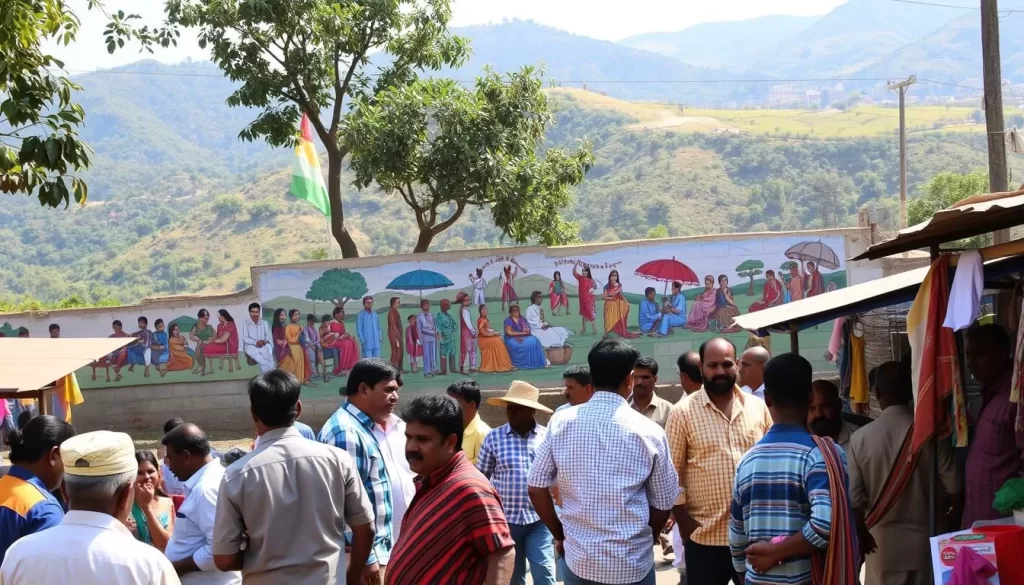
Tamil Speakers in Andhra Pradesh
Tamil speakers are found in significant numbers in the border regions of Andhra Pradesh, particularly near the Tamil Nadu border. The proximity to Tamil Nadu has resulted in linguistic and cultural exchanges, with many Tamil-speaking communities maintaining their language and traditions.
Kannada Influence in Border Regions
The border areas adjacent to Karnataka have a notable presence of Kannada speakers. This linguistic influence is a result of the geographical contiguity and historical ties between the regions. Kannada has contributed to the linguistic diversity of Andhra Pradesh, especially in areas near the Karnataka border.
Odia and Other Neighboring Languages
In the northern border regions of Andhra Pradesh, you’ll discover a significant presence of Odia speakers. The proximity to Odisha has created linguistic exchange zones, where Odia has influenced local dialects and vice versa. Additionally, other minority languages such as Marathi are found in certain border areas, contributing to the rich linguistic tapestry of the state. These border languages create unique cultural blends in transition zones and reflect the historical connections between different states.
As you explore these border languages, you’ll understand how speakers navigate multilingual environments and maintain their cultural identity. The presence of these languages not only adds to the linguistic diversity of Andhra Pradesh but also highlights the state’s position as a cultural crossroads.
Tribal Languages of Andhra Pradesh
Tribal languages in Andhra Pradesh are not just means of communication but are deeply intertwined with the cultural heritage of the region. The state’s Scheduled Tribes speak a variety of languages, including Lambadi (Banjari), Gondi, Konda, Koya, Chenchu, and Yerukula.
Gondi and Konda Languages
Gondi and Konda are two significant tribal languages spoken in Andhra Pradesh. Gondi is spoken by the Gond tribe, one of the largest tribal communities in the region. While Konda is spoken by the Konda community, it is known for its rich oral traditions. Efforts are being made to document and preserve these languages through linguistic research and cultural programs.
Koya and Chenchu Languages
Koya is another important tribal language, known for its unique grammatical structure. The Chenchu language, spoken by the Chenchu tribe, is characterized by its distinct cultural expressions. Both languages are crucial to the identity of their respective communities and are being preserved through community-led initiatives.
Preservation Efforts for Tribal Languages
The preservation of tribal languages in Andhra Pradesh is a multifaceted effort involving government programs, NGO initiatives, and community participation. Digital technology plays a significant role in documenting and teaching these endangered languages. Education is also being used as a tool to maintain linguistic diversity among tribal communities. You can see the positive impact of these efforts in the revitalization of tribal languages, contributing to the rich cultural heritage and diversity of the region.
English in Andhra Pradesh
English is increasingly becoming a crucial language in Andhra Pradesh, bridging the gap between local and global communities. As the state’s economy continues to grow, particularly in the IT sector, the importance of English language proficiency has become more pronounced.
English in Education and Administration
In Andhra Pradesh, English plays a significant role in education and administration. Many educational institutions use English as a primary medium of instruction, especially in professional courses like engineering and medicine. This has led to an increased demand for English language skills among students and professionals alike. The state’s administration also uses English extensively in official communications, making it an essential language for government officials and those seeking to interact with government agencies.
| Sector | Role of English | Impact |
|---|---|---|
| Education | Primary medium of instruction in many institutions | Increased demand for English language skills |
| Administration | Used in official communications | Essential for government officials and public interactions |
English as a Language of Opportunity
Proficiency in English has become a key factor in unlocking economic and professional opportunities in Andhra Pradesh. The state’s growing IT industry and international business connections have created a high demand for individuals with strong English language skills. As a result, English has become a language of social mobility, enabling individuals to access better education, job opportunities, and global networks. The private English language education industry has also seen significant growth, catering to the needs of those seeking to improve their English proficiency.
As you explore the role of English in Andhra Pradesh, you’ll find that it serves as a gateway to global education and career opportunities. The state’s emphasis on English language education is likely to continue, driven by the need to remain competitive in the global economy.
Language Demographics and Statistics
Understanding the linguistic landscape of Andhra Pradesh requires a deep dive into its language demographics. The state’s population speaks a variety of languages, with significant numbers of people speaking Telugu, Urdu, and Hindi.
Language Distribution by Region
The distribution of languages in Andhra Pradesh varies significantly by region. In the coastal regions, Telugu is the predominant language, spoken by the majority of the population. In contrast, areas like the Rayalaseema region have distinct dialects and linguistic features. Urdu is also widely spoken, particularly in urban areas.
Nearly one-third of the population lives in urban areas, with about half of these urban dwellers residing in the state’s 10 most populous urban areas, notably around Visakhapatnam and Vijayawada.
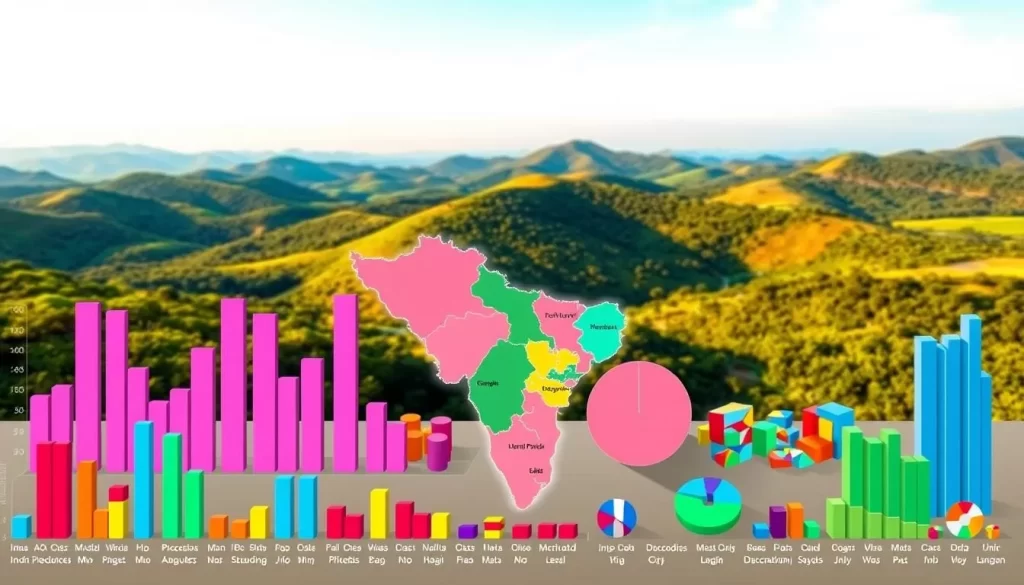
Urban vs. Rural Language Patterns
There’s a notable difference in language usage between urban and rural areas of Andhra Pradesh. Urban centers tend to have a higher prevalence of English and Hindi, driven by factors like education and occupation. In contrast, rural areas preserve traditional dialects and linguistic features. Migration to cities also affects language patterns, creating urban linguistic diversity.
You’ll find that in urban settings, the number of people speaking multiple languages is higher, with over 1 spoken million people using English as a second language. In rural settings, the number of million speakers for local dialects remains significant.
Andhra Pradesh, India: Official and Widely Spoken Languages in Education
Education is a vital sector where the official and widely spoken languages of Andhra Pradesh are not just taught but also used as mediums of instruction. The state’s educational framework is designed to accommodate its linguistic diversity.
Medium of Instruction in Schools
The medium of instruction in schools across Andhra Pradesh varies, reflecting the state’s linguistic diversity. Telugu, being the official language, is widely used as a medium of instruction in many schools. The government has implemented the three-language formula, which includes Telugu, English, and another language, often Hindi or Urdu, to promote multilingualism among students.
This approach not only helps students become proficient in multiple languages but also fosters cultural understanding and exchange. However, the implementation can vary between schools, with some focusing more on English as a medium of instruction to enhance global competitiveness.
Language Learning Opportunities
Andhra Pradesh offers various language learning opportunities beyond the standard curriculum. Specialized language institutes and programs are available for learning different languages, including Telugu, Urdu, and English. Technology has also created new avenues for language acquisition, with online courses and digital resources becoming increasingly popular.
Students in Andhra Pradesh can benefit from these diverse learning opportunities, enhancing their language skills and connecting with their cultural heritage. The state’s focus on education and language learning prepares students for a multilingual and multicultural world.
Language Policies and Government Initiatives
Language policies in Andhra Pradesh are designed to preserve and promote the state’s rich linguistic heritage. The government has been actively involved in implementing initiatives that support the development of local languages.
State Language Policies
The state has formulated specific language policies aimed at promoting Telugu and other local languages. These policies focus on education, cultural preservation, and administrative usage. For instance, Telugu is recognized as the official language of the state, and efforts are made to promote its use in official contexts.
Moreover, the state government has taken steps to protect and promote minority languages within Andhra Pradesh. This includes supporting literature and cultural events that celebrate linguistic diversity.
Promotion and Preservation Programs
Various programs have been launched by the government to promote and preserve language in Andhra Pradesh. These include initiatives to document endangered tribal languages, support literary works, and enhance language education. The central government also collaborates with the state to implement these programs effectively.
Furthermore, language academies and cultural institutions play a crucial role in supporting linguistic heritage. They work towards preserving traditional languages and promoting their use in modern contexts.
By understanding these initiatives, you can gain insight into the comprehensive approach taken by the government of Andhra Pradesh to safeguard its linguistic diversity.
Cultural Expression Through Languages
Language plays a pivotal role in shaping the cultural landscape of Andhra Pradesh. The region’s diverse languages are a testament to its rich cultural heritage, influencing various forms of artistic expression.
Literature and Poetry
The literary traditions in Andhra Pradesh are profound, with Telugu being a significant contributor. The works of poets and writers in Telugu have enriched the language, making it a classical language of India. You can explore the vast array of literature, from ancient scriptures to modern poetry, all reflecting the culture and values of the people.
Cinema and Media
Andhra Pradesh, particularly Telugu cinema, has a massive following not just within the state but across the world. The language used in these films often blends traditional and modern elements, appealing to a wide audience. You can witness how language is used to convey stories that resonate with people from different backgrounds.
Folk Traditions and Oral Heritage
The folk traditions in Andhra Pradesh are a vibrant part of its heritage. Folk songs, stories, and proverbs passed down through generations preserve the region’s history and cultural values. You can discover how these oral traditions are maintained through various languages, ensuring their survival and relevance in contemporary times.

Language and Identity in Andhra Pradesh
Andhra Pradesh’s rich linguistic heritage is fundamental to understanding the state’s cultural landscape and identity. The intricate relationship between language and identity is evident in the way Telugu, the official language, is cherished and promoted across the state.
Language as a Marker of Cultural Identity
You’ll discover how the Telugu language serves as a strong marker of cultural identity in Andhra Pradesh. The historical development of Telugu and its classical status have contributed significantly to the state’s cultural heritage. Telugu literature and poetry are replete with references to the region’s history, mythology, and cultural practices, further reinforcing the bond between language and identity.
Linguistic Pride and Regional Sentiment
Linguistic pride is deeply intertwined with regional sentiment in Andhra Pradesh. The emotional attachment to the Telugu language drives cultural and political movements, shaping regional consciousness and autonomy. You can see this pride expressed through various cultural celebrations and events that highlight the state’s linguistic heritage.
| Aspect | Description | Impact on Identity |
|---|---|---|
| Language | Telugu is the official language | Shapes cultural identity |
| Cultural Events | Celebrations like Telugu New Year | Reinforces linguistic pride |
| Historical Significance | Telugu’s classical status | Enhances regional sentiment |
Understanding the complex relationship between linguistic identity and political representation is crucial. Language continues to play a significant role in shaping regional politics and cultural expression in Andhra Pradesh.
Multilingualism and Language Shifts
Multilingualism is a defining feature of Andhra Pradesh, reflecting the state’s cultural diversity. The state’s linguistic landscape is shaped by various factors, including historical, geographical, and socio-cultural elements. According to the 2011 census, after thorough linguistic scrutiny, edit, and rationalization on 19,569 raw linguistic affiliations, the census recognizes 1,369 rationalized mother tongues and 1,474 names which were treated as ‘unclassified’ and relegated to ‘other’ mother tongue category.
Bilingualism in Andhra Pradesh
Bilingualism is a prevalent phenomenon in Andhra Pradesh, with many residents speaking more than one language. This bilingualism is often a result of the state’s linguistic diversity and its geographical location, bordering other linguistically distinct regions. The ability to speak multiple languages is seen as an asset, particularly in educational and professional contexts.
The table below illustrates the linguistic diversity and bilingualism in Andhra Pradesh:
| Language | Speakers | Context of Use |
|---|---|---|
| Telugu | Majority | Official, Home, and Cultural |
| Urdu | Significant minority | Community and Cultural |
| English | Educated population | Education, Administration, and Professional |
Changing Language Patterns Among Youth
The younger generation in Andhra Pradesh is experiencing a shift in language patterns, influenced by factors such as education, media, and globalization. There’s a growing trend towards adopting English and Hindi, alongside their native languages, leading to code-switching and the creation of hybrid language forms.
This shift is also driven by the aspirations of young people for better educational and career opportunities. As a result, there’s a tension between preserving local linguistic heritage and embracing global language trends.
Understanding these changing patterns is crucial for predicting the future linguistic landscape of Andhra Pradesh. As the state continues to evolve, its linguistic diversity will likely be shaped by both local and global influences.
Conclusion
Our journey through the linguistic landscape of Andhra Pradesh has revealed the complexity and beauty of the state’s language dynamics. As we’ve explored, Telugu is the official language of Andhra Pradesh, with a rich historical and cultural significance. With over 75 million speakers, Telugu is not only a widely spoken language in the state but also one of the classical languages of India.
The state’s linguistic diversity is further enriched by the presence of other languages, including Urdu, Hindi, and various tribal languages. You’ve learned about the different dialects of Telugu, such as the Coastal Andhra and Rayalaseema dialects, and how they contribute to the state’s linguistic tapestry. Additionally, we’ve examined the role of English as a language of education and administration.
Understanding the languages spoken in Andhra Pradesh is crucial for appreciating the state’s cultural identity. Language plays a significant role in shaping the cultural expression, education, and identity of the people. By exploring the linguistic diversity of Andhra Pradesh, you’ve gained insights into the complex dynamics of language use in the state.
As we’ve discussed, language policies and government initiatives play a vital role in promoting and preserving the languages of Andhra Pradesh. Efforts to document and promote tribal languages, for instance, are essential for maintaining the state’s rich linguistic heritage. With a solid foundation in the linguistic landscape of Andhra Pradesh, you’re now well-equipped to appreciate the complexities of language use in this diverse Indian state.
In conclusion, the linguistic diversity of Andhra Pradesh is a significant aspect of its cultural fabric. By understanding the various languages and dialects spoken in the state, you’ve gained a deeper appreciation for the complexities of language dynamics in this region of India. As you move forward, you can apply this knowledge to further explore the rich cultural heritage of Andhra Pradesh.
The above is subject to change.
Check back often to TRAVEL.COM for the latest travel tips and deals.
